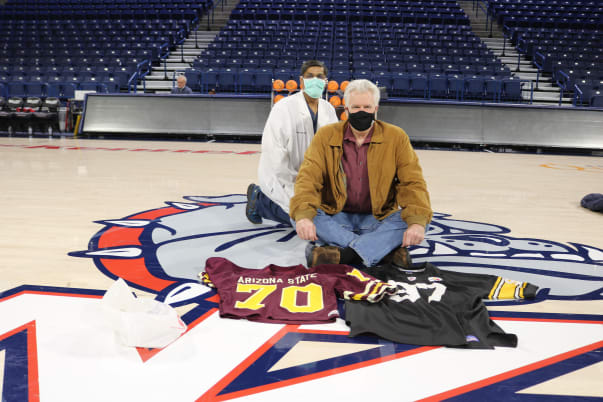By Meredith Bailey
It was way back in high school when John Meyer first began to wonder why he would get so winded while running.
“I’d be playing basketball or some other sport and couldn’t figure out why I was the only one breathing so hard,” says Meyer. “I always just thought that I needed to push myself more.”
And push, he did.
Meyer went on to play football at Arizona State University where he was named an All-American. After a decorated career as an offensive lineman for the Sun Devils, he was selected as a second-round draft pick by the Pittsburgh Steelers. At six-foot-six inches, Meyer had both speed and instincts, qualities that caught the coaches’ attention and drew comparisons to former Steelers who had earned a spot in football’s Hall of Fame. But in 1982, during his rookie season, a knee injury spelled the end of Meyer’s professional football career.
By then, his knee injury wasn’t his only health concern. Meyer’s shortness of breath during physical activity had become more frequent and intense; there were moments during games where he couldn’t catch his breath at all.
And yet, it took over three decades for Meyer to get a correct diagnosis and the treatment he needed.
“When I finally found a doctor who figured out what was going on, he told me something I’ll never forget — how surprised he was that I had made it in professional sports as far as I did,” says Meyer.
Dismissed, unheard
While his NFL career culminated in 1982, Meyer’s medical journey was just getting started. It wasn’t long before he was struck with migraines. His shortness of breath got so bad he couldn’t go on walks or wash the dishes without becoming exhausted. Taking a trip to Costco became “an act of God.” He would get dizzy spells and pass out while walking from one room to the other. Meyer’s mental health suffered as well — he grew depressed and rarely left the house.
Over the years, Meyer went to the emergency department multiple times and saw dozens of doctors, but no one could unravel the mystery. Most providers attributed his symptoms to his former career as a football player, but deep down Meyer knew that wasn’t it, so he didn’t give up.
A doctor who listens
In 2019, Meyer started seeing David Fisher Jr. MD, an internist at MultiCare Rockwood Clinic, and finally got the help he needed. Dr. Fisher referred him to Mohit Jain, MD, an interventional cardiologist with the Pulse Heart Institute team at MultiCare Deaconess Hospital.
“Because of everything I had gone through, I thought it was likely Dr. Jain would dismiss me or tell me it’s all in my head like most of the other doctors had,” says Meyer. “But he listened, and he promised me we were going to do a thorough investigation.”
Initial rounds of testing didn’t indicate anything abnormal, but Dr. Jain kept his promise to get to the bottom of Meyer’s symptoms.
“My mentors taught me that you always listen to a patient, to what they’re experiencing — not just test results.” says Dr. Jain. “If someone is still hurting, you’ve got to go to the next step, and that’s what we did.”
Their perseverance paid off. More rounds of testing, including a coronary angiography and a fractional flow reserve, revealed that Meyer had a congenital heart defect known as a myocardial bridge.
Typically, the arteries that deliver blood and oxygen to the heart are located on its surface, but in Meyer’s case one of those arteries was positioned beneath layers of heart muscle, so every time his heart contracted (or squeezed), it would cut off the blood supply — resulting in a spasming sensation and the other symptoms Meyer was experiencing.
“Most people who have this heart condition don’t have problems because the majority of blood flow happens when the heart is relaxing — not squeezing,” says Dr. Jain. “But there are certain individuals who do suffer from it, and their symptoms can get worse over time. It turned out that John was one of those people.”
For Meyer, the solution was open heart surgery to remove the heart muscle fibers encasing his artery. It’s a very delicate procedure that few surgeons are able to perform. Dr. Jain reached out to his colleagues and was able to connect Meyer with a cardiac surgeon at Stanford University.
“One of the benefits of Pulse Heart Institute is that we aren’t just cardiologists in Spokane or Tacoma,” says Dr. Jain. “We’re a statewide team that works together, exchanges ideas and makes connections with other specialists, inside and outside of our organization. Our priority is getting people the best care, wherever that care may be.”
Find your own Dr. Jain
After undergoing a successful surgery in 2021, Meyer is on the path to recovery. His migraines and dizzy spells have ceased. He can go for a walk and perform household tasks without growing short of breath. There has also been one surprising outcome of his surgery.
“I always thought that I was a person who didn’t dream at night,” says Meyer. “But as soon as I had the surgery, I started dreaming like crazy — what a difference proper blood flow makes.”
In November 2021, Meyer was honored through the Heart of the Zags program. A partnership between Gonzaga University and Pulse Heart Institute, Heart of the Zags features a Pulse patient during half time of Gonzaga men’s home basketball games. Featured patients receive Pulse Heart Institute gear as well as free tickets to the game.
As for Meyer’s future, he wants to help others through volunteering once he has fully recovered, and he has an important message for anyone who is struggling with health problems.
“Listen to your intuition. Don’t let go of hope because you never know what tomorrow will bring. Keep going until you find your own Dr. Jain,” says Meyer.




